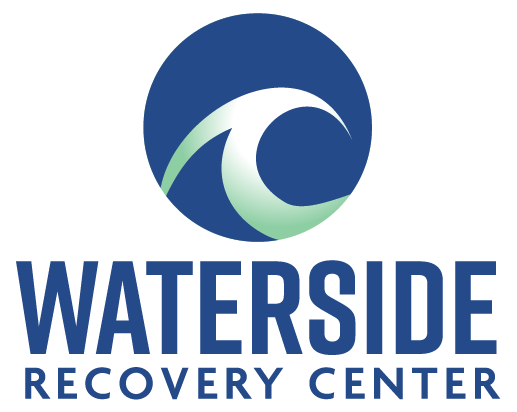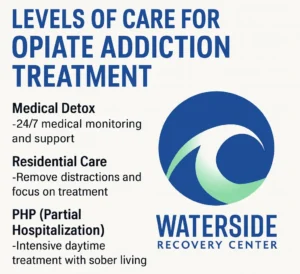When Your Child Is in Crisis, Clarity Can Feel Like a Lifeline
When you’re the parent of a young adult struggling with opiate addiction, it often feels like you’re treading water—desperate to keep your head above the waves, but unsure which direction leads to shore. Maybe you’ve Googled treatment options until 2am. Maybe you’ve sat through rushed phone calls with insurance. Maybe your child is willing to try again—but no one has clearly explained what “treatment” even looks like.
At Waterside Recovery, we’ve walked alongside hundreds of families asking the same questions: What happens after detox? How do I know what my child needs? What if they leave too soon?
Let’s break it down. Gently, clearly, and step by step.
What Are “Levels of Care” in Opiate Addiction Treatment?
Opiate addiction isn’t solved overnight. It’s a medical and emotional condition that affects every part of a person’s life—from their brain chemistry to their relationships. That’s why treatment is designed in phases, often called levels of care.
Each level offers a different intensity of support, structure, and supervision. The goal isn’t to rush through them—it’s to meet your child where they are and help them move forward safely and steadily.
Think of it like physical rehab after a major injury. At first, they might need round-the-clock care. Later, they can return home but still need therapy and check-ins. It’s the same with addiction recovery: stabilization first, followed by rebuilding, then long-term support.
Medical Detox: Safety Comes First
What it is: 24/7 medical supervision during withdrawal from opiates.
Why it matters: Opiate withdrawal is painful and sometimes dangerous. Detox helps manage those symptoms safely.
During detox, clients may receive medication to ease withdrawal symptoms, prevent complications, and stabilize their system. It’s a physically intense few days—and emotionally vulnerable, too. Your child might be scared, disoriented, or overwhelmed. That’s normal.
Detox is not the full solution, but it’s often the first step. Without it, the path forward can’t begin.
Residential Treatment: Structure and Emotional Healing
What it is: Live-in care that combines therapy, group work, daily routines, and clinical supervision.
Why it matters: Once your child is physically stable, they need a safe, focused environment to begin the deeper emotional work of recovery.
Residential programs provide a buffer from outside stressors—friends who still use, academic pressure, family tension—and create space for healing. Clients engage in individual therapy, group therapy, trauma-informed care, and life skills training.
For many young adults, this is where they begin to name what hurts underneath the substance use—grief, fear, shame—and learn tools to stay grounded without drugs.
Partial Hospitalization Program (PHP): The Bridge Between
What it is: Intensive daytime treatment (typically 5–6 hours a day), with evenings spent at home or in sober housing.
Why it matters: PHP offers clinical structure while allowing clients to begin practicing real-world independence.
PHP is often the next step after residential treatment—or a first step for clients who don’t require 24/7 supervision. It provides continuity of care, ongoing therapy, and peer support, while helping your child begin re-entering life: making meals, managing their schedule, and rebuilding trust.
Here in Plymouth County, MA, we’ve seen how PHP can help parents exhale a little. Your child is still in care, but now they’re practicing the skills that will carry them forward.
Intensive Outpatient Program (IOP): Independence with Support
What it is: Flexible programming—typically 3–4 hours, 3–5 days a week—with continued therapy, group sessions, and recovery coaching.
Why it matters: IOP supports clients who are working, going to school, or living at home—but still need structured support.
IOP helps young adults strengthen their relapse prevention skills, improve communication, and stay connected to recovery even as their external life picks up speed. This level of care allows them to handle more responsibilities, while still having a clinical safety net.
It’s also a time when family therapy may play a bigger role. Healing the parent-child relationship is often just as vital as helping the client stay sober.
Outpatient and Aftercare: Staying Connected for the Long Run
What it is: Weekly therapy sessions, support groups, medication management, and alumni engagement.
Why it matters: Recovery doesn’t end when treatment does. Staying connected helps prevent relapse and deepens emotional stability.
Some young adults attend therapy once a week. Others stay involved in alumni programming or step-down groups. The right mix depends on your child’s needs, mental health status, and support system.
At Waterside, we emphasize aftercare planning early—because your child deserves more than a discharge date. They deserve a plan they believe in, with people who’ll walk with them as long as it takes.
Ready to Take the First Step?
If your child is struggling with opiate addiction, you’re not alone—and you’re not out of options. Waterside Recovery offers full-spectrum opiate addiction treatment in Plymouth County, MA, with personalized care that meets clients where they are. Whether they need detox, residential support, or flexible outpatient care, we’re here to help you find the right fit.
Call (866) 671-8620 or visit to learn more.
Frequently Asked Questions About Opiate Addiction Treatment
How do I know what level of care my child needs?
A clinical assessment is the first step. Our team evaluates each client’s physical health, substance use history, mental health needs, and living situation to determine the best level of care. You don’t have to figure this out alone.
Can my child go straight into outpatient care?
It depends. Some clients are appropriate for IOP right away, especially if they’ve detoxed recently or have strong support at home. Others may need residential or PHP first to build a solid foundation.
What if my child refuses treatment?
This is heartbreaking—but not uncommon. We can help guide conversations, offer support resources, and explore interventions. You don’t have to wait for things to get worse before seeking help.
How long does treatment take?
There’s no set timeline. Some stay in treatment for 30 days, others for several months. What’s important is tailoring the length of stay to your child’s needs—not rushing through a checklist.
Is treatment covered by insurance?
Often, yes. We work with many insurance providers and can help you understand your benefits. Finances shouldn’t be a barrier to getting help.
Do you offer support for families too?
Absolutely. We offer family therapy, education, and support throughout the treatment process. Healing is a family process—and you deserve care too.



